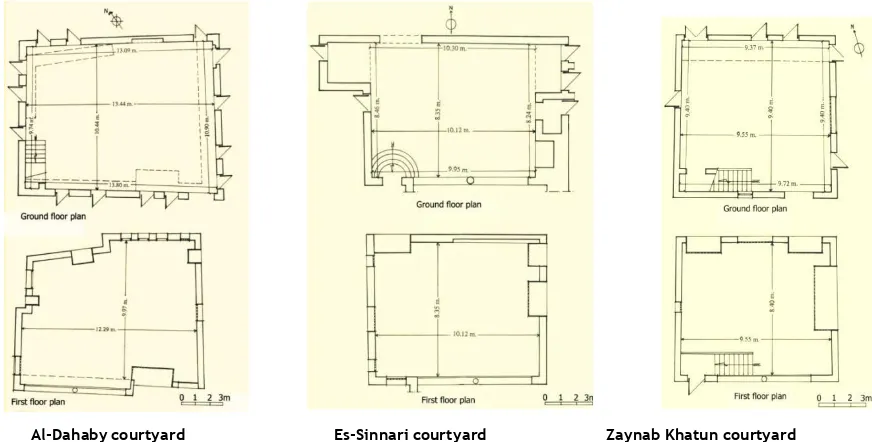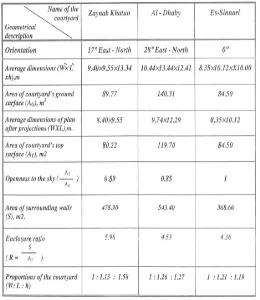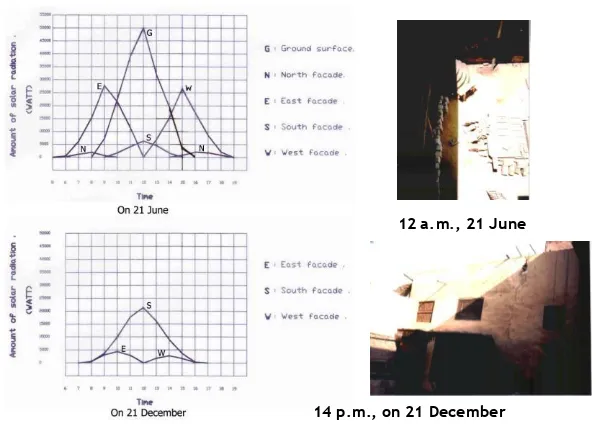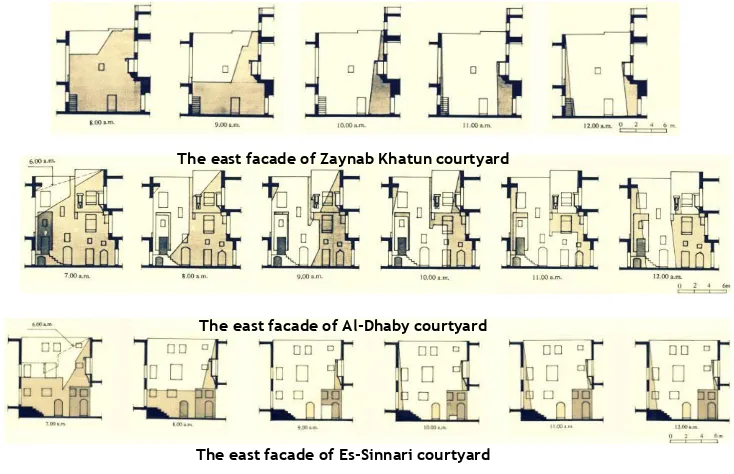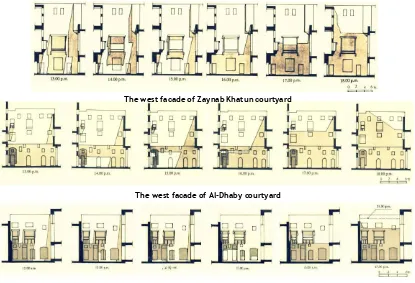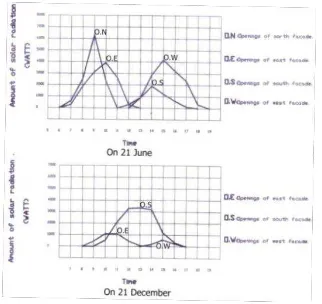COMPARATIVE STUDY BETWEEN THREE COURTYARDS OF
TRADITIONAL HOUSES IN ISLAMIC CAIRO
Yehia Hassan Wazeri Assistant professor- Dept. of Architecture
High Institute of Engineering & Technology, Al Arish, Egypt. E-mail: drwazeri@yahoo.com
Abstract
Direct solar radiation is considered the most important climatic element, which has direct and indirect influences on designing buildings and open spaces. In hot arid regions, like Cairo, the main aim is to reduce the heat load in summer, and to maximize it in winter. The aim of the present comparative study is to determine the shaded area and the quantity of direct solar radiation (on 21 June & 21 December) fall on walls, floors and openings of three courtyards in traditional Islamic houses in old Cairo. For this purpose a network of three traditional courtyards houses has been selected in old Islamic Cairo. The first is Zaynab Khatun house (built 1468AD), the second is Gamal Al-Din Al-Dahaby (built 1637AD), and the third is Es-Sinnari house (built 1794AD).
Key words: courtyards; traditional houses; Islamic Cairo.
Abstrak
Radiasi matahari langsung merupakan elemen iklim yang paling penting untuk dipertimbangkan dalam perancangan, baik yang memberikan pengaruh langsung maupun tidak langsung pada perancangan bangunan dan ruang terbuka. Di daerah kering dan panas, seperti halnya Cairo, beban panas di musim panas dikurangi dan dimaksimalkan di musim dingin. Tujuan dari penelitian yang menggunakan tiga studi banding ini adalah untuk menentukan daerah yang teduh dan melihat jumlah radiasi matahari langsung pada tanggal 21 Juni dan 21 Desember, yang mengenai pada dinding, lantai dan bukaan yang bersumber dari halaman rumah tradisional Islam di kota tua Kairo. Untuk itu, telah dipilih tiga rumah tradisional di Kairo yang memiliki halaman yaitu rumah Zaynab Khatun yang dibangun pada 1468AD, kedua rumah Gamal Al-Din Al-Dahaby yang dibangun pada 1637AD, dan yang ketiga adalah rumah Es-Sinnari yang dibangun pada 1794AD.
Kata kunci: halaman, rumah-rumah tradisional, Islam Kairo.
Introduction design in relation to the elements of climate.
Direct solar radiation is considered the most important climatic element, which has direct and indirect influences on designing buildings and open spaces. In hot arid regions, like Cairo, the main aim is to reduce the heat load in summer, and to maximize it in winter.
Courtyard thermal performance is mainly affected by the solar radiation penetration on the internal envelope. The courtyard building form can be an efficient modifier to the climatic conditions
if special arrangements are made at the early stages of the building design.
A case study is taken in relation to 28 Damascene courtyards houses.4 The study relied on analyzing the Iwan elevation as well as the inner courtyard proportion in relation to the building area.
The aim of the present comparative study is to determine the shaded area and the quantity of traditional courtyards houses has been selected in old Islamic Cairo from Ottoman period. The first is Zaynab Khatun house(built 1468AD), the second is
Gamal Al-Din Al-Dahaby (built 1637AD), and the third is Es-Sinnari house (built 1794AD).
Courtyards and Equations
The courtyards orientation and dimensions with its details of openings were determined, figure1. The photos and measurements for shaded and exposed areas of the courtyards were taken in some particular hours (on 21 June & 21 December).
Al-Dahaby courtyard Es-Sinnari courtyard Zaynab Khatun courtyard
Figure 1. The courtyards orientation and dimensions (The researcher)
Geometry equations of the courtyard: Openness to the sky may be determined from 5: Openness to the sky = AT/AG
Where:
AT = Area of the courtyard’s top surface.
AG = Area of the courtyard’s ground surface.
Enclosure ratio (R) may be determined from 6:
(R) = S / AT
Where:
S = Area of the surrounding walls of the courtyards
Determination of horizontal and vertical shadow angles:
Equations for calculating the intensity of direct solar radiation:
The hourly direct normal solar radiation (IDN)
data for Cairo station in Egypt were used. This data was obtained from the official files of the Authority of Meteorology at Kobry El-Koba in Cairo, on 21 June and 21 December. 10
radiation (IDN), corrected for the angle of incidence
IDV = The amount of direct solar radiation falling on
a vertical surface.
If the surface is a roof or other horizontal surface, the angle of incidence is simply the complement of the altitude angle of the sun 13:
(Z = 90O – A)
Where:
IDH = The amount of direct solar radiation falling on
a horizontal surface. Results and Discussion
Geometrical description of the investigated courtyards:
The geometries of the investigated courtyards are shown in table 1. From that table,
4- The proportion between width and length of the investigated courtyards not exceed 1:1.30.
Table 1. Geometries of the investigated courtyards (The researcher)
Shaded area ratio of the investigated courtyard
The calculations of the shaded area showed that the ground surface of Zaynab Khatun
values, 75%, 81% and 74%, 72% respectively. A relation between the increasing of shaded surfaces and the degree of enclosure of the courtyards was established.
In winter (21 December), the ground surfaces and north facades are 100% shaded, but the other facades are over 83% shaded of Zaynab Khatun, over 81% of Es-Sinnari and over 79% of Al-Dhaby.
Amount of solar radiation received by courtyards surfaces
On 21 June, It was observed that the ground surface of the three courtyards receive the largest
amount of solar radiation at 12.00 a.m. In Zaynab Khatun and Al-Dhaby courtyards, the west facades receive the largest amount at 15.00 p.m., while the east facade of Es-Sinnari receives the largest amount at 9.00 p.m. and the west façade at 15.00 p.m., figure 2.
On 21 December, the south façade of Zaynab Khatun and Es-Sinnari courtyards receive the largest amount of solar radiation at 12.00 a.m, while in Al-Dhaby courtyard at 14.00 p.m., figure 2.
10 am., on 21 June
12 a.m., on 21 December
Figure 2a. Curves of solar radiation amount received by Zaynab Khatun courtyard surfaces on 21 June and 21 December and some photos in particular time (The researcher)
12 a.m., 21 June
14 p.m., on 21 December
15 p.m., on 21 June
13 p.m., on 21 December
Figure 2c. Curves of solar radiation amount received by Al-Dhaby courtyard Surfaces on 21 June and 21 December and some photos in particular time (The researcher)
Because the investigated courtyards differ in size and orientation, the amount of solar radiation per unit area was used to compare them. From table 2, the following was observed:
- On 21 June, the ground surface of Zaynab Khatun courtyard receives the smallest amount of solar radiation and the ground surface of Es-Sinnari courtyard receives the largest amount. The facades of Al-Dhaby courtyard receive the smallest amount of solar radiation, because they have the largest ratio of projections when compared with the other two courtyards. Es-Sinnari facades receive the largest amount of solar radiation because they did not have any projections.
- On 21 December, Al-Dhaby courtyard receives the largest amount of solar radiation.
- Taking in the consideration the total amount of solar radiation received by ground surface and the facades together (without North façade), it was found that Zaynab Khatun courtyard receives the smallest amount.
Because the north facades of the three courtyards receives the smallest amount of solar radiation on 21 June, the summer "Meka'ad" (open reception men space in the first floor) and "Al Taktabosh" (open reception men space in the ground floor) are located in this façade.
Table 2. Average amount of solar radiation per unit area received by the courtyards surfaces on 21 June
and 21 December (The researcher)
Amount of solar radiation received by courtyards openings
55.50% in Es-Sinnari courtyard. The shaded and exposed area and openings of the north facades on 21 June are shown in figure 3.
The ratio of openings of east facades is 2.82% in Zaynab Khatun courtyard, 16.51% in Al- Dhaby courtyard and 18% in Es-Sinnari courtyard. The shaded and exposed area and openings of the east facades on 21 June are shown in figure 4.
The ratio of openings of south facades is 22.28% in Zaynab Khatun courtyard, 11.66% in Al-
Dhaby courtyard and 16.92% in Es-Sinnari courtyard. The shaded and exposed area and openings of the south facades on 21 June are shown in figure 5.
The ratio of openings of west facades is 20% in Zaynab Khatun courtyard, 18% in Al-Dhaby courtyard and 23.34% in Es-Sinnari courtyard. The shaded and exposed area and openings of the west facades on 21 June are shown in figure 6.
The north facade of Zaynab Khatun courtyard
The north facade of Al-Dhaby courtyard
The north facade of Es-Sinnari courtyard
Figure 3. The shaded and exposed area and openings of the north facades on 21 June (The researcher)
.
The east facade of Zaynab Khatun courtyard
The east facade of Al-Dhaby courtyard
The east facade of Es-Sinnari courtyard
The south facade of Zaynab Khatun courtyard
The south facade of Al-Dhaby courtyard
The south facade of Es-Sinnari courtyard.
Figure 5. The shaded and exposed area and openings of the south facades on 21 June (The researcher)
The west facade of Zaynab Khatun courtyard
The west facade of Al-Dhaby courtyard
The west facade of Es-Sinnari courtyard
The amount of solar radiation received by courtyards openings (on 21 June and 21 December) is represented in figure 7.
It was found that the openings of west façade of Zaynab Khatun and Al-Dhaby courtyards receive the largest amount of solar radiation, where the openings of the east façade of Es-Sinnari courtyard receive the largest amount on 21 June (summer).
On 21 December, the openings of south façade of the three courtyards receive the largest amount of solar radiation.
When comparing the average amounts of solar radiation per unit area of openings received by the courtyards, table 3, it was found that the openings of Es-Sinnari and Zaynab Khatun courtyards receive the smallest amount on 21 June (summer). Where the openings of Al-Dhaby courtyard receive the largest amount of solar radiation on 21 June and 21 December.
Figure 7a: Curves of solar radiation amount received by Zaynab Khatun courtyard openings on 21 June and 21
December (The researcher)
Figure 7b. Curves of solar radiation amount received by Al-Dhaby courtyard openings on 21 June and 21
December (The researcher)
Figure 7c. Curves of solar radiation amount received by Es-Sinnari courtyard openings on 21 June and 21
December (Theresearcher).
Table 3. Average amount of solar radiation per unit area received by the courtyards openings on 21 June and 21
December (The researcher)
Conclusion
A study of the exposed and shaded surfaces and openings on 21 June (over heated period) and on 21 December (under heated period) was carried out in three courtyards in old Islamic Cairo from Ottoman period.
The average height of the investigated courtyards does not exceed one and half the width, except for Zaynab Khatun courtyard, where w: h = 1: 1.58. Increasing the walls height of Zaynab Khatun openings ratio and arrangement with respect to solar radiation. Because the north facades of the three space in the ground floor) are located in this façade.
In applying the results, one can design a new courtyard house with reference to the geometrical relationships and facades projections and openings discovered in the traditional courtyard houses without copying it.
References
1 A. Younes. and M.A. A.Mohsen. 1980. The courtyard as s passive solar design means in buildings. The international congress on solar energy, Istanbul
2 M. Al Hussayen. 1995. Significant characteristics and design considerations of the courtyard house. Journal of Architectural and planning research, Chicago, vol. 12, No. 2
3 A. Muhaisen. 2006. Shading simulation of the courtyard form in different climatic regions. Building and Environment 41 (2006) 1731–1741
4 S. Ferwati and A. Mandour .2008. Proportions and human scale in Damascene courtyard houses. International Journal of Architectural Research, Vol. 2 – No. 1 (247-263) (Available in:
(M.Sc.Thesis). Faculty of Engineering,
Department of Architecture, Cairo
University.(In Arabic)
9 Ibid
10 Y.Wazeri, 1997. The relationship between solar radiation and building design in North Africa (M.Sc.Thesis). Institute of African research and studies, Department of Natural resources, Cairo University
